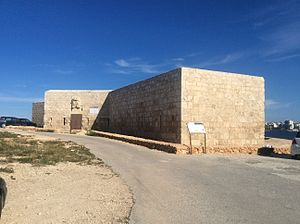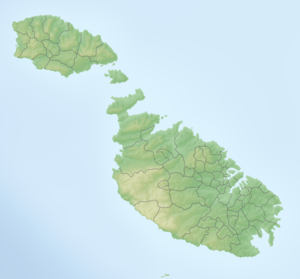Mistra Battery
| Mistra Battery | ||
|---|---|---|
| Alternative name (s): | Batterija valley-Mistra | |
| Creation time : | 1714-1716 and 1761 | |
| Castle type : | Coastal battery | |
| Conservation status: | restored | |
| Construction: | Limestone - masonry | |
| Place: | Mellieħa | |
| Geographical location | 35 ° 57 '30.5 " N , 14 ° 23' 41.9" E | |
|
|
||
The Mistra Battery is a fortification on the island of Malta , built during the reign of the Order of St. John in the 18th century . Even before its restoration, which began in 2013, it was considered the best-preserved historical battery on the island.
history
In the 17th century, under the grand masters Wignacourt , Lascaris and de Redin, the Johanniter had equipped Malta with a dense network of coastal watch towers. Their main task was to detect the approach of an enemy fleet at an early stage and to alert the garrisons in the fortified cities. In the 18th century, the defense strategy of the order changed so that the claim was now to actively fight enemy fleets and to prevent the enemy from landing on the islands. Shallow coastlines were protected by the establishment of well-armed batteries and redoubts . The building plans were drawn up in 1714 by Jacques de Camus d'Arginy, Bernard de Fontet and François Bachelieu. An influential advocate of the project was the French Grand Prior of the Order, Philippe de Vendôme , who personally donated 40,000 Scudi .
Together with the Buġibba Battery and the Arrias Battery , the Mistra Battery was supposed to defend St Paul's Bay and its secondary bay Mistra Bay. Its construction was already provided for in the plans from 1714, but progressed only slowly. A document from 1743 shows that their log houses did not have any roof structures at that time. The Maltese historian Stephen C. Spiteri is of the opinion that the battery, begun in 1714, was originally only built as a gun platform and was only equipped with a land-based fortification under Grand Master Manuel Pinto de Fonseca - probably in 1861. At that time, there were nine cannons , three 24-pounders and six 8-pounders on the gun platform. As early as 1770, only one cannon, an 8-pounder, is said to have been in the battery, in 1785 there were none. At the beginning of the 20th century, the buildings served as a coast guard station to combat smuggling .
Since 1995 the Mistra Battery has been on the list of cultural properties of Malta ( National Inventory of the Cultural Property of the Maltese Islands ) under number 1397 .
description
The battery, made of limestone masonry, consists of a semicircular platform facing the lake for the cannons as well as residential and warehouse buildings in the rear. On the land side, the position is completely protected by the walls of the two log houses and a V-shaped bastion (Redan). The latter gave the defense the opportunity to the room just before the walls, they could not see, to sides of loopholes , which are both in the Redan and in the walls of log houses with muskets to spread . The Redan has a battlement which enabled the defenders to move from the roof of one log house to that of the other. The gun platform is surrounded by a parapet with battlements with three windows for the 24 pounders in the northeastern part . In front of the parapet there is a trench cut into the rocky subsoil. The battery is entered through a narrow door in the Redan, which was formerly provided with a drawbridge . The coats of arms of Grand Master Pinto de Fonseca and Bailli de Montagnac are placed above the door .
Restoration and reconstruction
In 2013, commissioned Malta Environment and Planning Authority , the Fondazzjoni Wirt Artna with the faithful reconstruction of the Mistra Battery. Previously, under'd monument standing historic fortification of a fish farm of Pisciculture Marine de Malte Ltd. served as a warehouse, which the renovated property returned to the state after 46 years of lease. Landlord Artna freed the stone floor of the gun platform from a 15 cm thick layer of concrete, restored the stone floors in the log houses, completed the parapet which was partially no longer in place, rebuilt the loopholes that had been enlarged to form windows, dug the trench again and erected the battlements on the Restore parapets. Only traditional materials and techniques were used. The cost in the first 18 months of the restoration was almost € 300,000. Landlord Artna started a call for donations in 2014 or 2015 in order to be able to refill nine cannons for installation on the gun platform for € 50,000.
Until 2019, the reconstructed Mistra Battery was not opened to the general public. However , it can be viewed or rented on request from the landlord Artna .
Individual evidence
- ↑ Stephen C. Spiteri: Campaigning for Rihama Battery ( Memento from January 30, 2015 in the web archive archive.today ). Military Architecture, August 28, 2012 (English).
- ↑ a b Mistra Battery - 1714 ( Memento from January 30, 2015 in the web archive archive.today ). Landlord Artna (English).
- ↑ Stephen C. Spiteri: 18th Century Hospitaller Coastal Batteries ( Memento December 12, 2015 in the Internet Archive ), 2010 (English).
- ↑ Stephen C. Spiteri: Guarding Against Contagion: Vigilance and the Role of Fortifications in Malta during the Outbreak of Plague in Messina in 1743 (PDF; 610 kB). In: Journal of Baroque Studies . Volume 2, No. 1, 2017, pp. 177-200 (English).
- ^ A b The Mistra Battery Cannon Project . Wirt Artna (English), accessed on February 25, 2019.
- ↑ Mistra Battery in Malta Military , accessed February 25, 2019.
- ↑ Information board at the Mistra Battery (Maltese / English), seen on February 14, 2019.
- ↑ Mistra Battery (PDF; 4.0 MB) in the National Inventory of the Cultural Property of the Maltese Islands from June 28, 2013 (English), accessed on March 3, 2019.
- ^ Charles Debono: Fortifications - Mistra Battery at http://www.mellieha.com (English), accessed on February 25, 2019.
- ↑ James Debono: From Pinto's battery to fish farm store . In: Malta Today , June 22, 2008, accessed February 26, 2019.
- ↑ L-Inħawi tal-Imġiebaħ u tal-Miġnuna (PDF; 11.5 MB). Natura 2000 Management Plan, Malta Environment and Resources Authority, 2014, accessed February 26, 2019.
- ^ Restoration of Mistra Battery almost completed. Fondazzjoni Wirt Artna (English), accessed on February 27, 2019.
- ^ Trespassers into Mistra Battery to be prosecuted. Fondazzjoni Wirt Artna (English), accessed on February 27, 2019.
- ^ Museums and Attractions. Fondazzjoni Wirt Artna , accessed on February 28, 2019.
Web links
- Mario Farrugia: Model drawing of the Mistra Battery with the armament from 1761 on the website of the Wirt Artna Foundation




